Charlie Dog is an animated cartoon character in the Warner Brothers Looney Tunes series of cartoons. The character was featured in nine cartoons between 1941 and 1958. He is generally characterized as a friendly wise guy.

Merrie Melodies is an American animated comedy short film series distributed by Warner Bros. Pictures. It is the companion series to Looney Tunes, and featured many of the same characters as the former series. It originally ran from August 2, 1931, to September 20, 1969, during the golden age of American animation, though it had been revived in 1979, with new shorts sporadically released until June 13, 1997. Originally, Merrie Melodies placed emphasis on one-shot color films in comparison to the black and white Looney Tunes films. After Bugs Bunny became the breakout character of Merrie Melodies and Looney Tunes transitioned to color production in the early 1940s, the two series gradually lost their distinctions and shorts were assigned to each series randomly.

Fresh Hare is a Warner Bros. Merrie Melodies cartoon directed by Friz Freleng, written by Michael Maltese, and produced by Leon Schlesinger. It was released to theatres on August 22, 1942.

Life with Feathers is a 1945 Warner Bros. Merrie Melodies animated short film directed by Friz Freleng. The short was released on March 24, 1945, and is the first cartoon to feature Sylvester the Cat, who is unnamed in this short.

Birds Anonymous is a 1957 Warner Bros. Merrie Melodies animated short, directed by Friz Freleng and written by Warren Foster. The short was released on August 10, 1957, and stars Tweety and Sylvester.
Babbit and Catstello are fictional characters, based on the comedic duo Abbott and Costello, that appeared in Warner Bros. animated cartoons. The characters appeared in four cartoons between 1942 and 1946: once as cats, once as dogs, and twice as mice.

Dough for the Do-Do is a 1949 Warner Bros. Merrie Melodies cartoon directed by Friz Freleng. The short was released on September 2, 1949, and stars Porky Pig. The short is a remake of Bob Clampett's 1938 cartoon Porky in Wackyland, as well as using footage from his 1943 cartoon Tin Pan Alley Cats.

Fast and Furry-ous is a 1949 Warner Bros. Looney Tunes cartoon, directed by Chuck Jones and written by Michael Maltese. The short was released on September 17, 1949, and stars Wile E. Coyote and the Road Runner, in their debut.

An Itch in Time is a 1943 Warner Bros. Merrie Melodies cartoon, directed by Bob Clampett. The short was released on December 4, 1943 and features Elmer Fudd, with a dog and cat that look similar to Willoughby and Claude Cat.
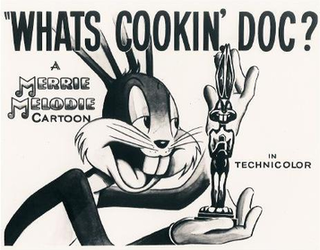
What's Cookin' Doc? is a 1943-produced, 1944 Warner Bros. cartoon in the Merrie Melodies series, directed by Bob Clampett, and stars Bugs Bunny. The short was also written by Michael Sasanoff, and was animated by Robert McKimson, along with uncredited work by Rod Scribner, Phil Monroe and Virgil Ross. The film was released on January 8, 1944.
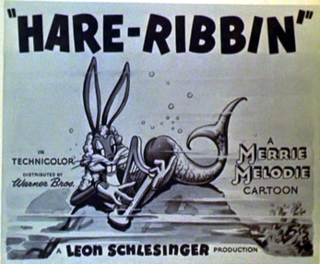
Hare Ribbin' is a 1944 animated short film in the Merrie Melodies series, directed by Robert Clampett and featuring Bugs Bunny. The plot features Bugs' conflict with a red-haired hound dog, whom the rabbit sets out to evade and make a fool of using one-liners, reverse psychology, disguises and other tricks. It was released in theaters by Warner Bros. on June 24, 1944. The title is a pun on "hair ribbon".

Buckaroo Bugs is a 1944 American Western Looney Tunes cartoon film directed by Bob Clampett. The cartoon was released on August 26, 1944, and features Bugs Bunny in his official Looney Tunes debut.
This is a listing of all the animated shorts released by Warner Bros. under the Looney Tunes and Merrie Melodies banners between 1940 and 1949.
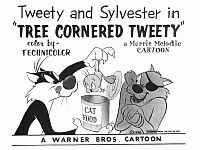
Tree Cornered Tweety is a 1956 Warner Bros. Merrie Melodies cartoon directed by Friz Freleng. The short was released on May 19, 1956, and stars Tweety and Sylvester. The title is a play on "three-cornered hat".

Gopher Broke is a 1958 Warner Bros. Looney Tunes cartoon short directed by Robert McKimson. The cartoon was released on November 15, 1958, and features the Goofy Gophers and the Barnyard Dawg. The voices are performed by Mel Blanc and Stan Freberg. The title is a pun on the phrase "go for broke".

Birdy and the Beast is a 1944 Warner Bros. Merrie Melodies directed by Bob Clampett. The short was released on August 19, 1944, and stars Tweety.

Mexican Boarders is a 1962 Warner Bros. Looney Tunes cartoon short directed by Friz Freleng. The short was released on May 12, 1962, and stars Speedy Gonzales and Sylvester. Voice actors are Mel Blanc, and Tom Holland as the narrator.
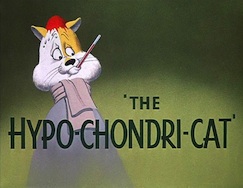
The Hypo-Chondri-Cat is a 1950 Warner Bros. Merrie Melodies short directed by Chuck Jones and written by Michael Maltese. The cartoon was released on April 15, 1950 and stars Hubie and Bertie and Claude Cat. The title is a play on "hypochondriac".
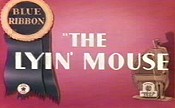
The Lyin' Mouse is a 1937 Warner Bros. Merrie Melodies cartoon directed by Friz Freleng. The short was released on October 16, 1937.
A Gander at Mother Goose is a 1940 Warner Bros. Merrie Melodies cartoon directed by Tex Avery and written by Dave Monahan. The short was released on May 25, 1940.
















